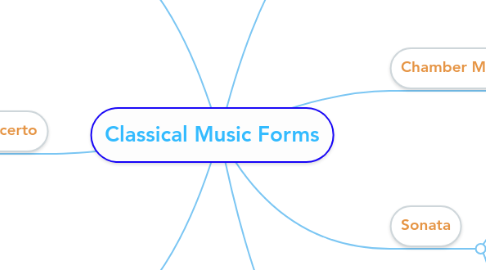
1. Symphony
1.1. A large-scale work for full orchestra.
1.2. Usually consists of four movements or sections, often alternating fast-slow.
1.3. Beethoven's ninth symphony was the first to break with tradition in that he included vocal soloists and a full choir into the final movement.
1.4. Other composers who wrote well-known symphonies are:
1.4.1. Haydn (wrote 104 of them)
1.4.2. Mozart
1.4.3. Schubert
1.4.4. Brahms
1.4.5. Tchaikovsky
1.4.6. Mahler
1.4.7. Prokofiev
1.4.8. Shostakovich
2. Concerto
2.1. Also a large-scale work for full orchestra but with the addition of an instrumental soloist
2.1.1. Most commonly this is a piano, violin or cello, but can be any instrument of the orchestra.
2.2. The interplay between the orchestra and the soloist is the distinguishing feature of the concerto.
2.3. Vivaldi's Four Seasons is a collection of four violin concertos.
2.4. Other great concertos include:
2.4.1. the piano concertos of
2.4.1.1. Mozart
2.4.1.2. Beethoven
2.4.1.3. Tchaikovsky
2.4.2. the violin concertos of
2.4.2.1. Beethoven
2.4.2.2. Brahms
2.4.2.3. Tchaikovsky
2.4.2.4. Sibelius
2.4.3. the cello concertos of
2.4.3.1. Dvorak
2.4.3.2. Elgar
3. Suite
3.1. A collection of short musical pieces, usually dances, to form a larger work.
3.2. Can be for orchestra or solo instrument.
3.3. Best known are
3.3.1. Tchaikovsky's Nutcracker suite
3.3.2. Respighi's Ancient Airs and Dances.
4. For more great mind maps, head to www.Biggerplate.com
5. Opera
5.1. Operas are very large scale pieces that are a mixture of music and theatre
5.2. Operas usually contain a full orchestra, solo singers and choir, who are required to act as well as sing.
5.3. Operas can also be enjoyed for their music content alone.
5.4. Well known operas are
5.4.1. Mozart's Magic Flute
5.4.2. Bizet's Carmen
5.4.3. Wagner's Ring cycle
5.4.3.1. a huge set of four operas
5.4.4. Puccini's Madame Butterfly
6. Chamber Music
6.1. A quaint definition is that chamber music is for a small group of listeners
6.2. More precisely, it is for a small group of performers
6.2.1. ranging
6.2.1.1. for one (eg a sonata)
6.2.1.2. to about six or eight (a sextet and octet)
